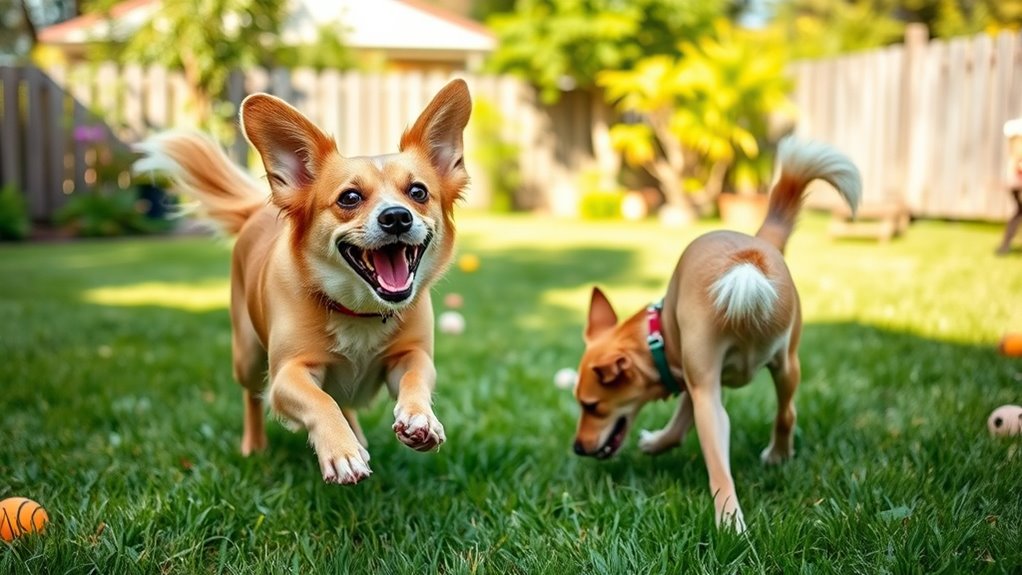To understand your dog’s body language, look for relaxed breathing, loose jaw, and a soft expression to spot happiness. Tense muscles, pinned-back ears, and tucked tail show stress or fear, while wagging tails and bright eyes signal excitement. An upright posture with direct eye contact indicates confidence or possible aggression. Pay attention to tail, ear, eye, and paw cues—these subtle signals reveal their true feelings. Keep exploring to master these vital signs and strengthen your bond.
Key Takeaways
- Recognize signs of relaxation like soft eyes, loose muscles, and a wagging tail to identify a happy dog.
- Identify stress signals such as pinned ears, tucked tail, and avoidance behaviors to ensure safety.
- Notice playful cues like bouncing, excited barking, and high wagging tails to understand a dog’s enthusiasm.
- Detect aggression or discomfort through growling, stiff posture, raised hackles, and direct stare.
- Observe ear, tail, eye, and paw positions to accurately interpret a dog’s emotional state.
Recognizing Relaxed and Happy Postures

When a dog is relaxed and happy, their body language clearly shows it. You’ll notice calm breathing, which indicates they’re comfortable and at ease. Their chest rises and falls gently, not rapidly or shallowly, signaling a peaceful state. A relaxed jaw also plays a key role; it feels loose, with no tension or clenched teeth. You might see their mouth slightly open, sometimes with a soft, content expression. Their ears are usually in a neutral position, not pinned back or overly alert. The tail, if visible, may gently wag or hang loosely. Overall, these signs show your dog feels safe and happy. Recognizing these relaxed postures helps you bond with your pet and ensures you’re aware of when they’re truly content. Additionally, understanding body language cues can help you identify when your dog is completely comfortable and stress-free. Being attentive to these signals can also aid in preventing stress and anxiety in your dog before it escalates. Observing their body language regularly allows you to notice subtle relaxation signals, reinforcing your connection and trust with your dog.
Signs of Stress and Anxiety in Dogs

Dogs often show clear signs of stress and anxiety through their body language, alerting you that they’re uncomfortable or overwhelmed. You might notice lip licking, yawning, or avoiding eye contact, which are subtle cues of distress. Tense muscles, pinned-back ears, or a tucked tail further indicate unease. Excessive grooming or scratching can be a sign of discomfort, possibly linked to poor canine nutrition or skin issues caused by stress. Changes in behavior, such as refusal to eat or clinginess, also signal anxiety. Recognizing these signs helps you respond calmly and avoid escalating their stress. Adjusting their environment, providing a calm space, and ensuring proper grooming and nutrition can help ease their anxiety and promote a sense of security. Monitoring body language signs like sweaty paws can also indicate elevated stress levels that require your attention. Additionally, understanding how proper nutrition impacts their overall health can aid in reducing stress-related symptoms. Being aware of body language cues can help you intervene early and support your dog’s emotional well-being. Incorporating calming techniques and stress management strategies can further improve their comfort and trust.
Indicators of Playfulness and Excitement

Recognizing when your dog is feeling playful and excited is essential for fostering positive interactions. Look for playful gestures like wagging tails, bows, or bouncing movements, which signal your dog’s enthusiasm. You might notice their eyes shining with anticipation, or they may bob their head up and down in excitement. Excited vocalizations, such as happy barking, squeaking, or playful growls, also indicate a high energy state. These signals show your dog is keen to engage and enjoy interaction. When you see these signs, it’s a good opportunity to play or bond, ensuring your dog feels understood and happy. Being attentive to these indicators helps strengthen your connection and promotes a positive, trusting relationship. Additionally, understanding dog body language can help prevent miscommunication and ensure both you and your pet feel comfortable and engaged. Recognizing these cues also involves noting subtle changes in posture that can reflect emotional states, which are important for maintaining a healthy and responsive bond. Paying close attention to behavioral cues can further enhance your ability to interpret your dog’s feelings accurately. Observing their overall demeanor and energy levels can provide deeper insights into their mood and well-being.
Body Language That Signals Fear or Submissiveness

When a dog shows signs of fear or submission, you might notice a tucked tail, avoiding eye contact, or flattened ears and body. These signals indicate they’re feeling uneasy or unsure of the situation. Recognizing these cues helps you respond calmly and gently to ease their discomfort. Understanding trust issues in your dog can also help you build a stronger bond and create a more secure environment. Being aware of fear signs can prevent escalation and help you intervene appropriately. Additionally, understanding body language can improve communication and ensure your dog feels safe and understood. Incorporating automation in training techniques can also support consistent responses and reinforce positive behavior. Staying informed about AI vulnerabilities can help you adapt your training methods to better address behavioral challenges.
Tucked Tail Posture
A tucked tail is a clear sign that a dog feels fearful or submissive. When you see a dog tucking its tail, it’s displaying submissive signals through tail tucking. Here’s what you might notice:
- The tail is held low or completely between the legs.
- The dog’s body appears crouched or hunched.
- Ears may be pinned back alongside the tail.
- The dog avoids eye contact and appears tense.
- This body language can be similar to that of a flat iron bike rider slowing down to signal caution. Recognizing tail tucking is also important because it indicates the dog might be experiencing fear or anxiety, which can influence how you approach or handle them. This body language indicates the dog is trying to communicate that it’s uncomfortable or wants to avoid conflict. Recognizing tail tucking helps you understand that your dog is signaling submission or fear, so you can respond gently and help them feel safe.
Avoidance of Eye Contact
Dogs displaying fear or submission often avoid eye contact as a nonverbal way to signal their feelings. When they do this, they may seem shy or overwhelmed, especially during activities like dog grooming. This behavior can also be linked to their instinct to avoid confrontation or dominance challenges, like canine scent marking. To better understand, consider the following:
| Avoidance Behavior | Interpretation |
|---|---|
| Gaze shifts away | Sign of submission or discomfort |
| Quick glances | Trying to gauge your response |
| Avoids eye contact | Indicator of fear or uncertainty |
Recognizing these signals is crucial in dog body language to ensure your pet feels safe and understood. A dog’s body language, including body posture, can also provide important clues about their emotional state. Understanding animal communication helps foster a digital-friendly environment that supports positive interactions and reduces stress for your pet. Additionally, awareness of headphone jacks and their compatibility can improve your overall communication and interaction experience with technology.
Flattened Ears or Body
Flattened ears or a lowered, tense body are clear signs your dog feels scared or submissive. These signals often appear during stressful situations like dog grooming or unfamiliar environments. Recognizing breed specific signals helps you understand their mood better. For example:
- Ears pinned back against the head, indicating discomfort or fear.
- A hunched or lowered body, signaling submission or anxiety.
- Tail tucked between the legs, showing vulnerability.
- Avoidance of eye contact, reinforcing a submissive stance.
- Paying attention to body language cues can help you interpret their emotional state more accurately. Being aware of canine communication enhances your ability to respond appropriately and avoid misunderstandings.
These body language cues suggest your dog isn’t confident and may need reassurance or space. Respond calmly and avoid forcing interaction. Learning these subtle signals helps prevent escalation and builds trust, especially when charting breed tendencies or stressful encounters.
How Dogs Show Aggression or Dominance

When a dog feels threatened or wants to establish dominance, it often displays specific body language signals to communicate its intentions. You might notice growling, barking, or other aggressive dog vocalizations that serve as warnings. The dog may also engage in scent marking, rubbing its scent on objects or people to assert territory and status. An upright posture, direct stare, and raised hackles are common signs of dominance or aggression. The dog might also hold its head high and stand tall, making itself appear larger. These signals are meant to communicate confidence or warning, so it’s important to interpret them correctly. Recognizing these behaviors helps you respond appropriately, ensuring safety and understanding of your dog’s social cues. Additionally, body language is a key indicator of a dog’s emotional state and intentions.
Understanding Tail Movements and Positions

Understanding a dog’s tail movements and positions offers valuable insight into its emotional state. When you see a dog’s tail wagging, it often signals friendliness or excitement, but the speed and height matter. Here are some key signals to watch for:
A dog’s tail position and movement reveal its emotions—happy, relaxed, irritated, or scared.
- A high, rapid wagging tail indicates happiness or confidence.
- A slow, gentle wag suggests relaxation or contentment.
- Tail flicking or twitching quickly can signal irritation or agitation.
- A lowered tail that’s tucked between the legs shows fear or submission.
Interpreting Ear and Eye Cues

Ears and eyes are powerful indicators of a dog’s emotional state and intentions. Pay attention to their ear position: forward ears often show curiosity or alertness, while pinned-back ears signal fear or submission. Eye contact can reveal confidence or discomfort; a relaxed, soft gaze indicates friendliness, whereas wide eyes with dilated pupils suggest anxiety. Watch their paw placement—firm paws show confidence, while paws tucked under mean submission or fear. Dog tail wagging combined with ear and eye cues can clarify meaning: a wagging tail with relaxed ears and soft eyes usually signals happiness, but stiff tail wagging with pinned ears indicates alertness or agitation. Understanding these cues helps you respond appropriately and build trust.
| Ear Position | Eye Expression |
|---|---|
| Forward or alert | Soft, relaxed gaze |
| Pinned back | Wide eyes, dilated pupils |
| Tucked or lowered | Squinting or avoiding eye contact |
Frequently Asked Questions
How Can I Tell if My Dog Is Feeling Unwell From Their Body Language?
If you want to know if your dog feels unwell through their body language, look for changes in vocal cues and facial expressions. A dog that’s unwell may whimper, whine, or become unusually quiet. Their facial expressions might show drooping eyes, a furrowed brow, or a tense mouth. Pay attention to these signals, along with changes in posture or activity levels, which can indicate discomfort or illness.
What Are Subtle Signs of Discomfort or Pain in Dogs?
You might miss subtle discomfort or pain cues if you’re not looking closely. Watch for tiny changes like a slight tail tucking, ear flicks, or a hesitant stance—small signs that indicate discomfort. These subtle discomfort signals often go unnoticed but are essential. Recognizing these signs helps you respond early, preventing further pain or distress. Stay observant, and you’ll catch those quiet cues before they escalate into bigger issues.
How Does Age Affect a Dog’S Body Language Signals?
As your dog ages, their body language signals change. Younger dogs often display puppy playfulness, with wagging tails and energetic movements. In contrast, senior dogs tend to show relaxation, with slower movements and calmer expressions. You’ll notice less jumping and more resting, reflecting their comfort or possible health issues. Paying attention to these shifts helps you comprehend their needs and guarantees you support their well-being at every life stage.
Can Body Language Indicate a Dog’S Specific Breed or Personality Traits?
You might wonder if body language reveals a dog’s breed or personality traits. While certain signals like posture or tail position can hint at breed identification, they aren’t definitive. Personality cues, such as confidence or friendliness, are often expressed through behavior and body language, but they vary widely among individual dogs. So, don’t rely solely on body language for breed or personality insights; consider context, history, and other cues for a better understanding.
How Should I Interpret Mixed Signals When a Dog Shows Multiple Body Language Cues?
Ever wonder if your dog’s body language contradictions are just a secret code? When faced with conflicting signals, you’re interpreting conflicting signals and trying to decode mixed messages. Watch for subtle cues—tail wagging but ears back, for example—and consider context. Your dog might be unsure or testing boundaries. Trust your instincts, observe the overall body language, and give them time to clarify their true feelings.
Conclusion
By tuning into your dog’s body language, you open the door to a deeper bond and better understanding. When you catch those subtle shifts—be it a wagging tail or a wary glance—you can gently guide their feelings and build trust. Remember, every gesture whispers a story; listening closely transforms your relationship from mere companionship to heartfelt connection. Embrace these signals, and watch as your shared journey becomes more harmonious and filled with mutual respect.










